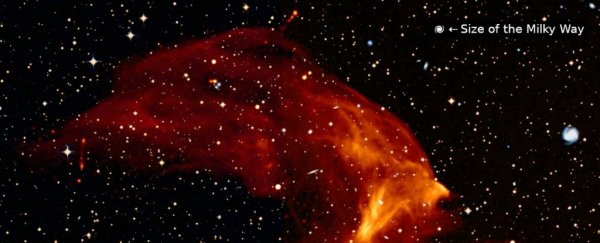A billion years ago, an absolutely monstrous collision of two clusters of galaxies produced a pair of shock waves of absolutely epic proportions.
Today, the structures gleam brightly in radio wavelengths, so huge they could easily engulf the Milky Way galaxy's estimated 100,000 light-year diameter, stretching up to 6.5 million light-years through intergalactic space.
Now, using the MeerKAT radio telescope in South Africa, a team of astronomers has made the most detailed study of these radio structures yet, gaining new insight into some of the most massive events in the Universe.
"These structures are full of surprises and much more complex than what we initially thought," says astronomer Francesco de Gasperin of the University of Hamburg in Germany and the National Institute for Astrophysics in Italy.
"The shock waves act as giant particle accelerators that accelerate electrons to speeds close to the speed of light. When these fast electrons cross a magnetic field they emit the radio waves that we see.
"The shocks are threaded by an intricate pattern of bright filaments that trace the location of giant magnetic field lines and the regions where electrons are accelerated."
 The magnetic fields of the main shock. (Francesco de Gasperin/SARAO)
The magnetic fields of the main shock. (Francesco de Gasperin/SARAO)
Galaxy clusters are the largest structures in the Universe that are bound together by gravity. They can be absolutely gigantic, containing hundreds or thousands of individual galaxies. Galaxies and galaxy clusters travel along filaments of the cosmic web to cluster nodes, where they join together to form even larger clusters.
These epic events happen at high velocities, generating cluster-scale shock waves that propagate through space, also at high velocities.
This particular cluster, called Abell 3667, is still coming together. At least 550 galaxies have been associated with it, and the shock waves are propagating through it at velocities around 1,500 kilometers per second (930 miles per second).
The shocks that are associated with cluster mergers are known as radio relics, and they can be used to probe the properties of the intergalactic space within the cluster, known as the intracluster medium, and intracluster dynamics.
Abell 3667, at around 700 million light-years away, is relatively close to us, and also quite massive, which means it's an excellent target for such probes.
 Both radio relics of Abell 3667. (Francesco de Gasperin/SARAO)
Both radio relics of Abell 3667. (Francesco de Gasperin/SARAO)
Because the cluster is in the southern sky, astronomers were able to look at it with one of the most sensitive radio telescopes in the world. MeerKAT is a precursor to and pathfinder for the Square Kilometre Array (SKA) that is currently being developed across Australia and South Africa to provide an unprecedented radio eye on the sky.
MeerKAT's observations, and those of the Australian Square Kilometer Array Pathfinder, are giving us a taste of the future; not just for the SKA, projected to see first light in 2027, but what we can find now.
"Our observations have unveiled the complexity of the interplay between the thermal and non-thermal components in the most active regions of a merging cluster," the researchers write in their study.
"Both the intricate internal structure of radio relics and the direct detection of magnetic draping around the merging bullet are powerful examples of the non-trivial magnetic properties of the intracluster medium. Thanks to its sensitivity to polarized radiation, MeerKAT will be transformational in the study of these complex phenomena."
The research has been published in Astronomy & Astrophysics.
